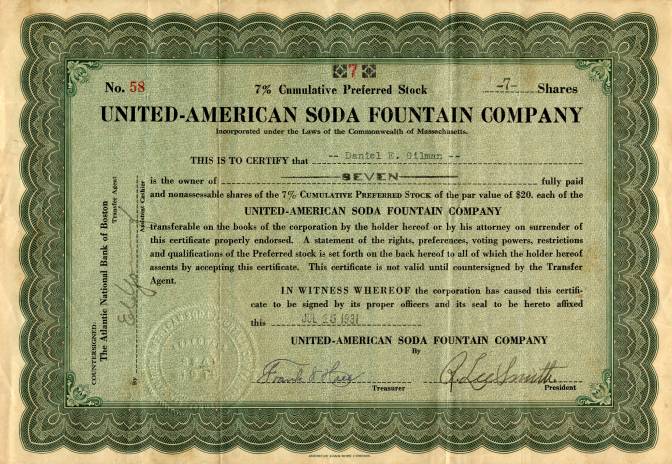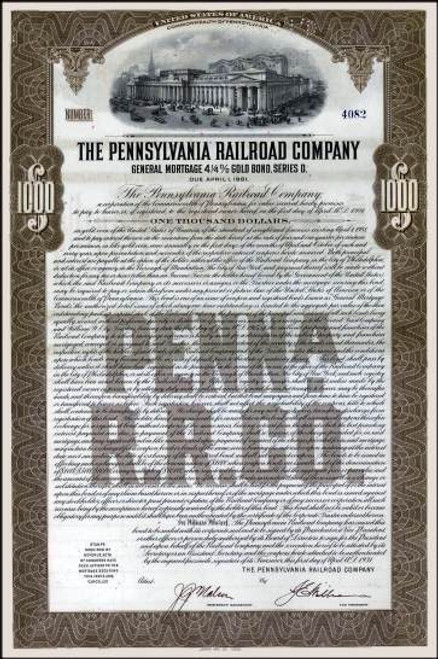Beautiful certificate from the United American Soda Fountain Company issued in 1931. This historic document was printed by the American Bank Note Company and has an ornate border around it with a vignette of the company name. This item has the original signatures of the Company's President, and Treasurer, and is over 82 years old. 
Certificate Manual of Statistics, Stock Exchange Hand-book 1913 AMERICAN SODA FOUNTAIN CO. A corporation formed under the laws of Maine, October 31, 1911 , in pursuance of a reorganization of a New Jersey corporation of the same title, formed in 1891 which took over the works and business of the largest manufacturers of soda water apparatus in the United States, including the Tufts and Puffer works at Boston, Matthews at New York and Lippincott at Philadelphia. It was reported in January, 1907, that the last named plant would be resold to the original owners. See below regarding the reorganization. Stock Par $100 Authorized, $1,350,000 Issued, $1,350,000 Stock is transferred at the office of the company, Boston. Registrar, Boston Safe Deposit & Trust Co., Boston. See Manual for 1913 for dividend record of the old company and details of the reorganization plan. The company's statement as of August 31, 1910, showed total assets, $1,457,120; surplus, $1,307,608; notes and accounts payable, etc., $130,159. The report of August 31, 1911, showed assets, $1,383,733; surplus, $1,333,565; other liabilities, $30,168; cash, $193,333; notes receivable, $544,951. President, James N. North, Boston. Vice-President, Leonard Tufts, Boston. Secretary, Thomas J. Morton, Jr., Boston. Treasurer, Isaac F. North, Boston. Directors--Charles N. King, Jersey City. Isaac F. North, Boston. James N. North, Boston. Thomas J. Morton, Jr., Boston. Charles F. Hope, New York. James O. Proctor, Jr., Boston. Eugene L. Tufts, Jr., San Francisco. Leonard Tufts, Pinehurst, N. C. Alfred B. White, Boston. Corporate office, Jersey City. Main office, 283 Congress street, Boston. Annual meeting in November, at Jersey City. -------------------------------------------------------------------------------- The soda fountain was an attempt to replicate mineral waters that bubbled up from the Earth. Many civilizations believed that drinking and/or bathing in these mineral waters cured diseases, and large industries often sprang up around hot springs, such as Bath in England or the many onsen of Japan. Early scientists tried to create effervescent waters with curative powers, including Robert Boyle, Friedrich Hoffmann, Jean Baptiste van Helmont, William Brownrigg, Antoine Laurent Lavoisier, and David Macbride. In the early 1770s, Swedish chemist Torbern Bergman and English scientist Joseph Priestley invented equipment for saturating water with carbon dioxide. In 1774 John Mervin Nooth demonstrated an apparatus that improved upon Priestley's design. In 1807 Henry Thompson received the first British patent for a method of impregnating water with carbon dioxide. This was commonly called soda water, although it contained no soda. The soda fountain began in Europe, but achieved its greatest success in the U.S. Benjamin Silliman, a Yale chemistry professor, was among the first to introduce soda water to America. In 1806 Silliman purchased a Nooth apparatus and began selling mineral waters in New Haven, Connecticut. Sales were brisk, so he built a bigger apparatus, opened a pump room, and took in three partners. This partnership opened soda fountains in New York City and Baltimore, Maryland. At roughly the same time, other businessmen opened fountains in NYC and Philadelphia. Although Silliman's business eventually failed, he played an important role in popularizing soda water. In 1832, John Matthews of NYC and John Lippincott of Philadelphia began manufacturing soda fountains. Both added innovations that improved soda-fountain equipment, and the industry expanded as retail outlets installed newer, better fountains. Other pioneering manufacturers were Alvin Puffer, Andrew Morse, Gustavus Dows, and James Tufts. In 1891 the four largest manufacturers--Tufts, Puffer, Lippincott, and Matthews--formed the American Soda Fountain Company, which was a trust designed to monopolize the industry. The four manufacturers continued to produce and market fountains under their company names. The trust controlled prices and forced some smaller manufacturers out of business. Before mechanical refrigeration, soda fountains used ice to cool drinks and ice cream. Ice harvesters cut ice from frozen lakes and ponds in the winter and stored the blocks for use in the summer. In the early 20th century, new companies entered the soda fountain business, marketing "iceless" fountains that used brine. The L.A. Becker Company, the Liquid Carbonic Company, and the Bishop & Babcock Company dominated the iceless fountain business. In 1888 Jacob Baur of Terre Haute, Indiana founded the Liquid Carbonics Manufacturing Company in Chicago, becoming the Midwest's first manufacturer of liquefied carbon dioxide. In 1903 Liquid Carbonic began market-testing its prototype iceless fountain in a Chicago confectionary. Louis A. Becker was a salesman who started his own manufacturing business in 1898, making the 20th-Century Sanitary Soda Fountain. In 1904 Becker's company produced its first iceless fountain. In 1908 William H. Wallace obtained a patent for an iceless fountain and installed his prototype in an Indianapolis drugstore. He sold his patent to Marietta Manufacturing Company, which was absorbed by Bishop & Babcock of Cleveland. Liquid Carbonic spawned another leading soda fountain manufacturer, the Bastian-Blessing Company. Two Liquid Carbonic employees, Charles Bastian and Lewis Blessing, started their company in 1908. The newer manufacturers competed with the American Soda Fountain Company and took a large share of the market. The trust was broken up, and its member companies struggled to stay in business. During WWI, some manufacturers marketed "50% fountains," which used a combination of ice and mechanical refrigeration. In the early 1920s, many retail outlets purchased soda fountains using ammonia refrigeration. In their heyday, soda fountains flourished in pharmacies, ice cream parlors, candy stores, dime stores, department stores, milk bars and train stations. They served an important function as a public space where neighbors could socialize and exchange community news. In the early 20th century, many fountains expanded their menus and became lunch counters, serving light meals as well as ice cream sodas, egg creams, sundaes, and such. Soda fountains reached their height in the 1940s and 1950s. In 1950, Walgreens, one of the largest chains of American drug stores introduced full self-service drug stores that began the decline of the soda fountain, as did the coming of the Car Culture and the rise of suburbia. Drive-in restaurants and roadside ice cream outlets, such as Dairy Queen, competed for customers. North American retail stores switched to self-service soda vending machines selling pre-packaged soft drinks in cans, and the labor-intensive soda fountain didn't fit into the new sales scheme. Today only a sprinkling of vintage soda fountains survive. In the Eastern Bloc countries, self-service soda fountains, located in shopping centers, farmers markets, or simply on the sidewalk in busy areas, became popular by the mid-20th century.[6] In the USSR, a glass of carbonated water would sell for 1 kopeck, while for 3 kopecks one could buy a glass of fruit-flavored soda. Most of these vending machines have disappeared since 1990; a few remain, usually provided with an operator. History from Wikipedia and OldCompany.com (old stock certificate research service) -------------------------------------------------------------------------------- The Soda Fountain, Volume 20 - October 1921 AMERICAN SODA FOUNTAIN COMPANY While it Is a fact that general business conditions during the past year have affected the soda fountain Industry somewhat, I do not believe it has been affected to anywhere near the extent that the basic Industries of the country have. Th soda fountain is no longer a luxury, as the public have com* to understand the food value of the beverages dispensed and it is safe to say that dispensers of soda fountain beverages have done as large If not a larger business than ever, during the past summer. As we have not been handicapped by a large inventory of material bought at wartime prices, we have been able to take advantage of the decline in prices on raw materials and have given our customers the benefit of our reduced costs, and our prices are now practically upon a pre-war basis. We are bringing out new styles for the coming season containing many refinements which will be furnished to our customers without increasing the price. Bankers all agree that we are entering upon an era of very cheap money and this will induce expansion of business In all lines which, of course, will benefit the soda fountain Industry as well as all other lines. As the dispensing of soda fountain beverages Is conceded *n be one of the most profitable lines of business, considering the too look small amount of capital required, I think, without being optimistic, that the soda fountain industry as a whole can look forward confidently to a large expansion in business from now on. I am backing my faith in the outlook by preparing for the largest business during the coming season that we have ever enjoyed. ISAAC F. NORTH, President. -------------------------------------------------------------------------------- AMERICAN SODA FOUNTAIN CO. Liquidation of Old Company. -- The shareholders of the old American Soda Fountain Co. of New Jersey (which was succeeded about three years ago by the American Soda Fountain Co. of Maine) voted at a special meeting, on May 5, 1914, to sell and dispose or all property of the company, real, personal and mixed, including good will and franchises, subject to liabilities. This step is taken simply to provide for the liquidation of the old New Jersey Corporation.--Boston News Bureau, May 0, 1914. New Corporation.--It was announced on July 11, 1914, that the American Soda Fountain Company of Maine had taken over the property of the American Soda Fountain Company of New Jersey, and would continue the business under the same management. The transfer has been effected in pursuance of the plan of reorganization. -- Boston News Bureau, July 11, 1914. History from Encyberpedia and OldCompany.com (old stock certificate research service)

Certificate








